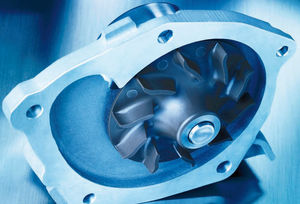
Coolant pump with electric motorfor automotive applicationsfor engine
Add to favorites
Compare this product
Characteristics
- Fluid
- for coolant
- Operation
- with electric motor
- Domain
- for automotive applications, for engine
- Applications
- cooling
- Other characteristics
- modular
- Power
Min.: 15 W
(0.02 hp)Max.: 400 W
(0.54 hp)
Description
Conventional pumps for engine cooling are driven by toothed belts and hence their output is coupled to engine RPM. Coolant pumps need to ensure sufficient cooling even at low engine RPM with high engine loads and at elevated outdoor temperatures, and so for normal operations (higher RPM and low load) they are inevitably oversized. The use of an electric coolant pump together with state-of-the-art thermal management of the combustion engine has measurable advantages. Demand-driven cooling, particularly in the cold-start phase, saves fuel (approx. 3 percent) and leads to a corresponding reduction in emissions. Moreover, improved air conditioning can achieve greater comfort in the passenger compartment. The lack of dependence on a mechanical drive also results in considerable flexibility in component packaging within the engine compartment.
The product selection from Pierburg Pump Technology covers the complete range of applications for electric water circulation and coolant pumps in the automotive industry.
The range includes water circulation pumps for stationary air conditioning, run-on and ancillary assembly cooling via electric coolant pumps for charge air and engine cooling. In
fact, our company has extensive experience in the area of electric water pumps, especially with regard to EC engine technology and hydraulics. Today in addition to more than
6 million mechanical coolant pumps, more than 6 million electric water circulation pumps and coolant pumps with electronically commutated motors are produced each year.
Catalogs
No catalogs are available for this product.
See all of Pierburg‘s catalogsRelated Searches
- Pump
- Pump with electric motor
- Clear water pump
- Centrifugal pump
- Chemical pump
- Lubricant pump
- Vacuum generator
- Compact pump
- Vacuum pump
- Lubricating oil pump
- Single-stage vacuum pump
- Mechanically-actuated pump
- Impeller pump
- Lubricated vacuum generator
- Lubricated vacuum pump
- Cooling pump
- Air pump
- Circulation pump
- Rotary vane vacuum generator
- Vane vacuum pump
*Prices are pre-tax. They exclude delivery charges and customs duties and do not include additional charges for installation or activation options. Prices are indicative only and may vary by country, with changes to the cost of raw materials and exchange rates.



